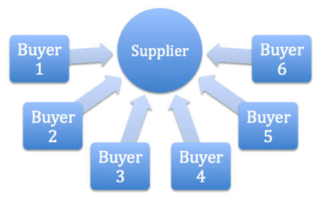Forward auction
Forward auction are auctions, which can be used by sellers to sell their items to many potential buyers.[1][2][3][4] Sellers and buyers can be individuals, organizations etc.

Items are commonly placed at a special site for auction (e.g. eBay.com or marketdojo.com or opt-source.com or salasarauction.com or oya.auction). Buyers can continuously bid for the items they are interested in. Eventually the highest bidder wins the item.
Two types of forward auctions are common. The first is a liquidate auction. Here buyers seek to obtain the lowest price for an item they are interested in. The second type is a marketing efficiency auction. Buyers wish to obtain a unique item.
References
- Turban, Efraim (2006). Information Technology Management: Transforming organizations in the digital economy. U.S.A.: John Wiley and Sons, Inc.
- Ganguly, D.; Chakraborty, Samit (2008). "E Commerce - Forward and Reverse Auction - A Managerial Tool to Succeed over Business Competitiveness". 2008 Ninth ACIS International Conference on Software Engineering, Artificial Intelligence, Networking, and Parallel/Distributed Computing: 447–452. doi:10.1109/SNPD.2008.51. ISBN 978-0-7695-3263-9.
- Preist, Chris; Bartolini, Claudio; Byde, Andrew (2003). "Agent-based service composition through simultaneous negotiation in forward and reverse auctions". EC '03: Proceedings of the 4th ACM Conference on Electronic Commerce: 55–63. doi:10.1145/779928.779936. ISBN 158113679X.
- Friedrich, Michael; Ignatov, Dmitry (2019). "General Game Playing B-to-B Price Negotiations" (PDF). CEUR Workshop Proceedings. Vol-2479: 89–99.
This article is issued from Wikipedia. The text is licensed under Creative Commons - Attribution - Sharealike. Additional terms may apply for the media files.